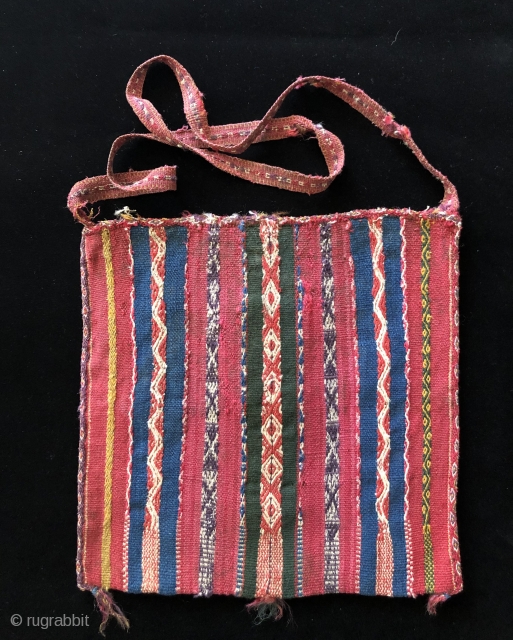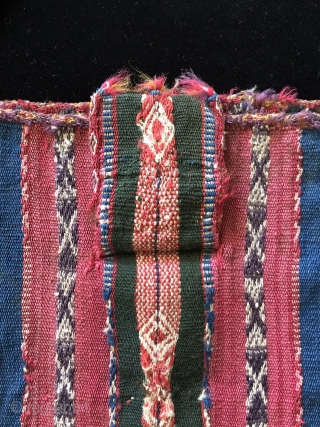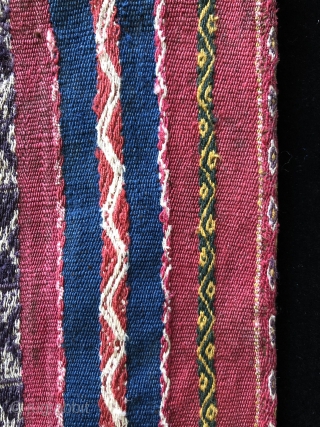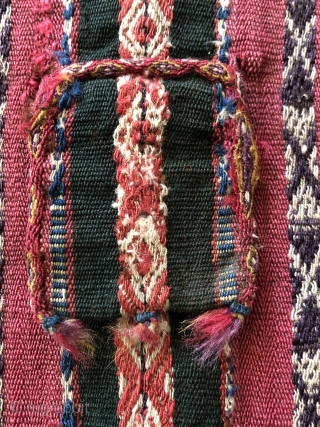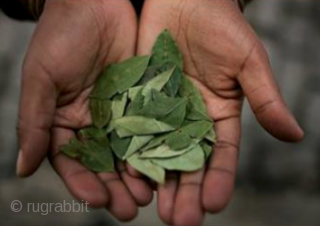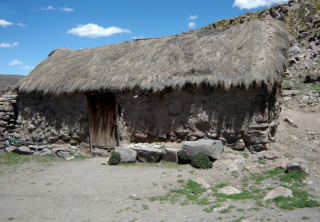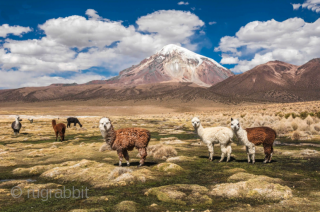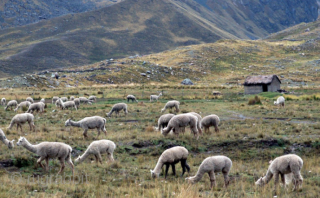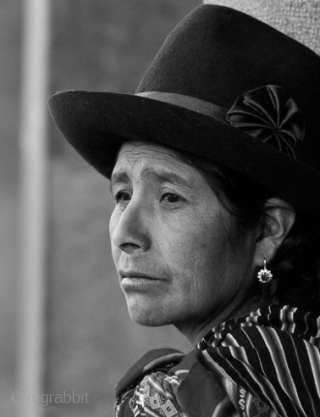Back
Tutorial part 3 - Anatomy of a Chuspa - a microcosm of the Aymara weaving arts.
Early Aymara coca bags like the one featured here are exceptionally rare. This example probably dates to the 18th century. Aymara people living in the remote Southern Altiplano region of Bolivia where this bag comes from mostly resided in small estancias or housing clusters spread out over vast areas to allow for adequate pasturage for their herds of alpacas and llamas. In general, weaving styles were similar over a broad region and can be loosely grouped as such. More specifically though, styles were provenance of Aymara weavers who occupied small clusters of thatch roofed, stone or adobe houses and were related by kinship or other ties. These were not tribal groups but something akin to them called ayllus whose members were joined by familial and territorial links. Aymara weavings from the 19th century and before survived in quite small numbers. It is important to understand that these micro-styles of textile design, color and other characteristics were always made as personal items for family members and not for sale or trade. This is because one’s clothing spoke to their specific identity and to that of their extended family. Consequently, these garments were not worn buy others outside of the community. In some cases the textiles that have survived represent the design and color aesthetic of a single weaver or weavers within a family unit. Because clothing announced who you were to your neighbors and the larger region, these textiles were not traded as commodities or for sale in markets like oriental rugs were for example.
The chuspa seen in this post is remarkable in several ways beyond just its great age. When a textile survives for more than two centuries while being kept in simple, primitive houses like those of the Aymara , it is indeed very rare. More importantly it attests to the great importance the Aymara placed on their textiles. i will write more on this in another post.
Perhaps the first thing to notice about this bag is that it is very large for an Aymara coca bag. Size: 11 x 11 inches. The oldest pieces often are large but this is not a hard and fast rule – just a good indicator of age. Also of significance, is that this bag has many of the techniques and features unique to the lexicon of Aymara weaving all rolled into one bag. It is a good example with which to start a journey into the subject of Aymara coca bags.
The opening of a chuspa is referred to by the Aymara as the mouth of the bag. It consumes the coca leaves. This bag has a second “mouth” that is accessed on the inside of the bag and is meant to contain a lime-like substance called llipta that when combined with coca in the mouth activates the alkaloids found in coca leaves. This small pocket seen on the outside of this bag is not sewn onto the bag. It is actually woven in. To do this the weaver makes the warps longer in the area of the small pocket when warping the loom and when she is at the place where the pocket is to be, she simply suspends weaving the surrounding area and weaves only the pocket section until it is long enough so that it can be folded and doubled back and sewn along the sides to form a pocket. Next she begins again to weave the full width of the bag until it is finished. This means that the contents of the small pocket has to be accessed from inside the coca bag. This technique has predecessors as seen in some Pre-Columbian bags - many of which were woven by Aymara speaking people in ancient times. It is a unique technical solution and one seen in a relatively small number of Aymara bags even into 19th/20th century. It is not an indicator of age, but of lineage and the conservative nature of Andean culture. Another technique that this bag shows off is the use of alternatively spun and plied yarns called lloq’e in Aymara. The Aymara believe that if one is ill or wants to ward off sickness, that spinning yarns with a direction of twist that is opposite of the usual direction will help prevent illness. So, instead of a z spin which would be usual , an s spin will do the trick. This type of yarn can be used in several ways in a weaving. First, since all yarns in Aymara weavings are two ply yarns the usual 2zs yarns are normal and the lloq’e yarns would be 2sz yarns. If the usual 2zs yarns are used in groups of say 10 warps next to each other and alternated with a grouping of 10 - 2sz (lloq’e) warps - then subtle stripes result because light reflects differently off of the alternately spun and plyed warps. This makes a very subtle color variation between the groups even though the yarns are the dyed the same color. i told you Aymara textiles are sophisticated. But wait. If differently spun and plyed yarns are used alternatively one next to the other then a subtle herringbone–like pattern is created. (Seen in the red areas on either side of the central pattern band.) It may be hard to see, but it’s here and produces a subtle special effect. This bag has both of these techniques used. Many Aymara weavings use lloq’e – often near the outer edges of a textile. Some say this is to help keep the edges from curling up, but I’m not sure about this aspect.
Aside from this subtle and magical use of spinning and plying called lloq’e there is another type of special effect that the Aymara weavers employ to dazzle - as they do in a subtle way - if that makes sense. It is called “chimi”. Chimi is the practice of plying two different colored yarns together in one warp yarn. This effect can be pronounced even when used sparingly as in this bag where the spinner plyed one white and one red yarn together into a bi-chrome yarn. It is often done where two quite similar colors are plyed together creating a more subtle blending. In using chimi yarns the Aymara leave every color combination on the table and they never miss. It is quite remarkable when it is used in wide areas of a weaving as a ground color because in concentrated form the eye blends these two differently colored yarns together creating in effect a third color, a new shade – a combination of the two. This is more often seen in larger weavings, but is found in coca bags to.
a feature of Aymara weaving that is easy to see in most bags, because it is most often found at the bottom of the bag is the disruption of the design in the pattern bands that run vertically down the bag. It is sometimes more visible on one side of a bag than the other. On this bag it is more prominent on the side without the pocket. It shows as a series of horizontal bars or a pebble or zipper like pattern. This area is called the termination area - the area where the bag is finished without the use of the heddle – usually with a needle. Aymara weavings are warp–faced and four selvedged meaning that they are not cut off the loom. The Aymara never cut warps to remove a finished weaving from the loom because this leaves loose ends like those seen in rugs as warp ends or fringes. The Aymara don’t like loose ends. They finish every weaving with no loose ends by weaving in one direction on the loom and then turning the loom and weaving back towards the area already woven until the heddles no longer work because the space is too tight. At this point they meticulously finish it off with fingers and then needles. In doing this they do not usually attempt to make the design stay the same in the pattern bands. Sometimes, the termination areas are quite small, sometimes not. Maintaining the integrity of the textile supersedes the continuity of design for them. Because this discussion is getting to be pretty drawn out, i will continue with it in another post. i haven’t discussed side and end finishes and straps yet . Also design meanings and colors - still lot to get to. i hope you’ll stay with me. fyi - All weavings in these tutorial posts are available for sale unless otherwise stated. If you’ve missed my previous posts on Aymara weaving and are interested please look at the following links for part 1 http://www.rugrabbit.com/node/214595
and part 2. http://www.rugrabbit.com/node/214759
price:
ALL SOLD
- Home
- Antique Rugs by Region
- Category
- Profiles
- Post Items Free
- Albums
- Benaki Museum of Islamic Art
- Budapest: Ottoman Carpets
- Gulbenkian Museum
- Islamic Carpets. Brooklyn
- Islamic Textiles. Brooklyn
- Konya Museum: Rugs
- MKG, Hamburg
- MMA: Caucasian Carpets
- MMA: Mamluk Carpets
- MMA: Mughal Indian Carpets
- MMA: Ottoman Carpets
- MMA: Safavid Persian Carpets
- MMA: Turkmen Rugs
- McCoy Jones Kilims
- Ottoman textiles. Met
- Philadelphia Museum
- Rugs and Carpets: Berlin
- Seljuqs at the Met
- TIEM, Istanbul: Carpets
- V&A: Classical Carpets
- Vakiflar Carpets: Istanbul
- Baluch Rugs: Indianapolis
- Gallery Exhibitions
- Jaf an Exhibition
- Alberto Levi Gallery
- Andean Textile
- Christie's London: 2016
- Francesca Galloway
- HALI at 40
- ICOC Washington, DC 2018
- Jajims of the Shahsavan
- London Islamic Week April, 2018
- Mongolian Felts
- Navajo Rugs: JB Moore
- Persian Piled Weavings
- SF Tribal & Textile Art Show 2020
- SF Tribal 2019
- Sotheby's: C. Alexander
- Turkish Prayer Rugs
- Turkmen Main Carpets ICOC 2007








